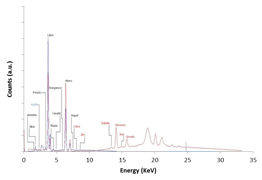- Xray Fluorescence -
Allows the chemical characterization of samples by means of the interaction of X-rays with the elements of the sample.
dating
morphology
technology
origin
composition
alteration

Ceramic

Glass

Metal

Mortar

Pigments

Stone
Ceramic Building Materials (CBM)
Widely used to identify the elemental* composition of their bodies, as well as the pigments used for their decoration (e.g. in the case of
glazed wall- pavement- or roof-tiles). Comparison of the XRF spectra of unknown ceramics with known clay lumps or with ceramics of known origin can link them to the clay pit where the raw materials (clay, temper and other inclusions) originate from or give an insight into ancient trade routes, respectively.
Glass
For historic glass characterization the XRF method provides information on its composition and allows element* mapping. Also can be studied production technology (from inclusions in the glass body), corrosion phenomena and decoration technique.
Metals & Alloys
Suitablefor for the determination of metal corrosion products for metal and alloy, and composition analyses (they are composed of heavy elements* which are easily detectable with this method).
Mortar & Plaster
Widely employed in mortar, plaster and wall paintings characterization.
Mortar bulk samples can be analysed and classified by identifying the nature of their binder: lime, gypsum, clay, cement, etc. However, for mortar classification, XRD is preferred as it provides information also about the crystalline structure of the binder.
Previously restored areas on wall paintings and frescoes can be revealed and - in some cases – indirectly dated by detecting characteristic elements*.
Pigments
On painted materials, XRF reveals the chemical composition of pigments, as well as their deterioration products (e.g. some pigments change chemical composition due to weathering).Elemental analysis* of pigments may provide useful evidence to date a mural, as well as to discover a pigment’s origin (from trace elements* included, which are characteristic of a geographic area).
Stone
Building or decorative stone materials can be non-destructively* characterized by means of XRF:

X-ray Fluorescence spectroscopy is a technique that performs qualitative*, semi-quanti- tative* and quantitative* characterization of most inorganic materials by identifying their elemental composition. Energy Dispersive X-ray Fluorescence (EDXRF) Spectrometry, in particular, is an extremely useful analytical tool for archaeologists and Cultural Heritage specialists, due to its non-destructive, fast, cost-effective and widely applicable character. Produces a spectra depicting elements’ relative concentration ratios.
accuracy
time
cost
in situ
invasive
destructive
- Good for mineral and inorganic material identification
- The non-destructive in-situ equipment provides good results for common cases
- The penetration of the X-ray varies depending on the material, therefore when there is a superposition of layers, the final compositional information will be a combination of an unknown number of these layers
X-rays are a short-wavelength (high-energy) type of radiation. A sample is bombarded with primary X-rays and emits secondary X-rays which are characteristic of the elements present in the specimen.
An XRF spectrometer is equipped with a detector that collects the secondary X-rays and appropriate software amplifies and transforms energy data into current signal. In the end a spectrum is obtained which contains two types of information:
- the energy of the peaks, (on the X-axis of the spectrum) which corresponds to the elements present in the sample (— qualitative analysis) and;
- the peak intensity (on the Y-axis of the spectrum) which corresponds to the relevant elemental concentration (number of X-rays emitted — semi-quantitative analysis).
The results are usually reported as element oxides (e.g. CaO, Al2O3, SiO2, P2O5), a generally accepted convention, since most elements naturally occur in their oxide form, making it also easier to compare with other analyses found in literature sources. Major and minor elements are expressed as percentages and trace elements* in ppm* (1000 ppm = 0,1%).